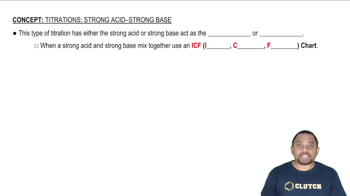Here are the essential concepts you must grasp in order to answer the question correctly.
Acid-Base Titration
An acid-base titration is a quantitative analytical method used to determine the concentration of an acid or base in a solution. In this process, a solution of known concentration (the titrant) is added to a solution of unknown concentration until the reaction reaches its equivalence point, where the amount of acid equals the amount of base. The pH changes during the titration, and understanding this change is crucial for calculating the pH at specific volumes of titrant added.
Recommended video:
Weak Acid and Strong Base Reaction
In this titration, propanoic acid acts as a weak acid, while KOH is a strong base. When a weak acid is titrated with a strong base, the pH at the equivalence point will be greater than 7 due to the formation of the conjugate base of the weak acid. The pH before the equivalence point can be calculated using the Henderson-Hasselbalch equation, which relates the pH of a buffer solution to the concentration of the acid and its conjugate base.
Recommended video:
Strong Acid-Strong Base Titration
Henderson-Hasselbalch Equation
The Henderson-Hasselbalch equation is a formula used to calculate the pH of a buffer solution. It is expressed as pH = pKa + log([A-]/[HA]), where pKa is the negative logarithm of the acid dissociation constant, [A-] is the concentration of the conjugate base, and [HA] is the concentration of the weak acid. This equation is particularly useful in titration problems to determine the pH at various points before reaching the equivalence point, especially when dealing with weak acids.
Recommended video:
Henderson-Hasselbalch Equation
 Verified step by step guidance
Verified step by step guidance


